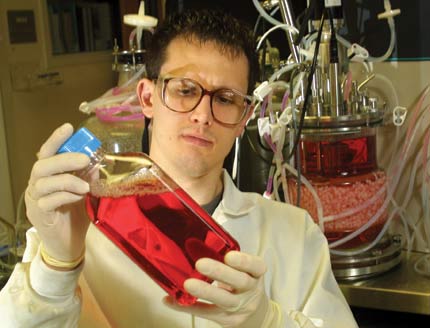downloadable
.pdf
Researchers
at Applied Genetic Technologies Corporation (AGTC), based
in UF's Sid Martin Biotechnology Development Incubator, are
exploring the use of adeno-associated virus, or AAV, as a
vehicle to deliver beneficial genes to critically ill patients.
UF
researchers Kenneth Berns and Nicholas Muzyczka pioneered
the use of AAV as a vector that could be modified to carry
corrective genes into the body. Berns is director of the UF
Genetics Institute, and Muzyczka is chairman of the board
of AGTC and an eminent scholar in the Department of Molecular
Genetics and Microbiology.
 |
Research
scientist David Knop looks over a subculture medium at
the laboratory of Applied Genetic Technologies Corp. in
Alachua. AGTC is using the adeno-associated virus, or
AAV, gene therapy
vector developed at UF to pursue genetic cures for emphysema
and other diseases. |
AGTC's
first product using AAV will treat Alpha-1 Antitrypsin Deficiency,
a disease that results in people as young as 25 developing
emphysema. Alpha-1 is caused by mutations in a single gene
that lead to a reduced level of a protein that normally protects
the lungs. Patients feel the current treatment for this disease,
a protein product taken by injection, is inadequate.
“Protein
replacement patients require weekly IV injections, which are
very expensive and painful,” says Dr. Terry Flotte,
an associate professor of pediatrics, molecular genetics and
microbiology in UF's College of Medicine who is conducting
clinical trials on the therapy. “Plus, there’s
been a limited supply of the protein.”
The
company is also developing products to treat Leber’s
Congenital Amaurosis, a form of congenital blindness; Pompe’s
Disease, which causes muscle weakness and death due to heart
failure; and Age-Related Macular Degeneration, a form of progressive
vision loss in people over 45.
“AAV
has all the properties required to treat a chronic disease
or a genetic disease, in that it has good efficiency for entering
cells, good stability once it gets a gene into the cell, and
the gene that
gets ‘turned on’ tends to stay activated
as long as the cell is around,” says Flotte. “It
also has a tremendous safety advantage over other viral gene-transfer
vectors.”
Unlike
some other vectors, AAV has not been linked to any side effects.
In fact, an estimated 80 percent of humans live with the virus
in their system, with no apparent illness.
Related web site: www.agtcfl.com
|


